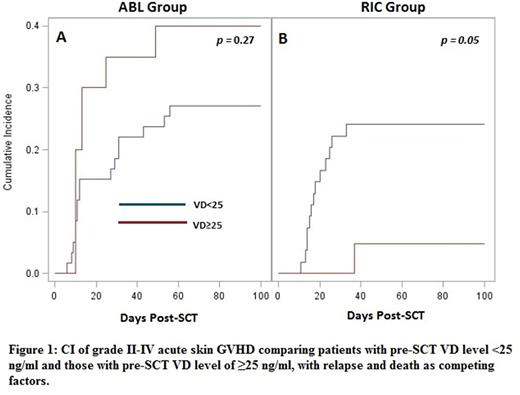Abstract
Introduction
Acute graft versus host disease (aGVHD) is a leading cause of morbidity and mortality in patients who undergo allogeneic hematopoietic stem cell transplant (SCT). aGVHD is thought to be initiated when donor T cells encounter recipient antigen presenting cells (APC) such as dendritic cells (DC) and become activated. Preclinical studies have shown that vitamin D (VD) inhibits DC maturation biasing T cell proliferation towards tolerating rather than alloreactive T cell populations [Rosenblatt et al. BMT 2010]. A study of 53 patients who underwent myeloablative (ABL) SCT showed pre-SCT VD <25 ng/mL was associated with increased cumulative incidence (CI) of chronic GVHD but not for aGVHD [Glotzbecke et al. BMT.2013]. Another study evaluating day-30 VD levels post-SCT in 54 patients showed that VD < 20 ng/mL was associated with increased risk of acute skin GVHD, but only in patients who underwent reduced intensity conditioning (RIC) [Ganetsky et al. Abstract # 416. BBMT. 2014]. Given the conflicting data of the effect of VD on the incidence of aGVHD, and small sample size of prior studies, we performed a retrospective analysis to evaluate whether pre-HSCT serum vitamin D levels were associated with acute skin GVHD in patients undergoing both ABL and RIC SCT.
Methods
One hundred fifty-four patients at the University of Texas Southwestern (UTSW) Medical Center who had serum samples banked prior to RIC or ABL conditioning and then underwent matched related (MRD) or unrelated (MUD) SCT from December 2007 to December 2014, were included in the analysis. CI of acute skin GVHD grade II-IV (asGVHD) was assessed within 100 days post-SCT. VD cutoff of 25 ng/mL was chosen based on receiver operating curve (ROC) analysis from a prior study [Glotzbecke et al. BMT.2013].
The shape and distribution of continuous variables was examined. Mean and standard deviations were calculated for continuous variables and percent's calculated for categorical data. The χ2-test and Fisher's exact test were used to compare categorical variables and Student's t-test was used to compare parametric data and calculate p values. Stratified analysis was performed to evaluate for presence of interaction between dichotomous VD variable and other covariates. Statistically significant interaction was found between VD levels and ABL vs. RIC regimens. We therefore stratified analysis of our primary endpoint, CI of grade II-IV asGVDH, into RIC and ABL groups. Kaplan-Meir (KM) curves for CI of asGVHD were constructed with death and relapse and competing factors. Difference between CI curves was tested using the Gray method.
Results
Out of 154 patients, 93 (60.3%) were male, mean age was 51 (range 20-72) and mean VD was 22.6 (range 7.6-63.6). Overall CI of asGVHD was 24%. Most patients (112, 72.7%) had with VD <25 ng/mL (VD<25). On bivariate analysis, conditioning regimen (ABL vs RIC), donor type (MRD vs MUD), cell source (peripheral blood vs bone marrow), age at SCT, and ABO compatibility were similar among those with VD levels <25 and ≥25. CI of asGVHD was 22.0% and 25.0% in VD≥25 and VD<25 groups, respectively (p=0.696).
Patients were then analyzed separately with respect to type of conditioning regimen they received (ABL and RIC). The ABL group had 79 patients with CI of asGVHD of 29.1% versus 18.6% in the 75 patients of the RIC group (p=0.12). In the ABL group, CI of asGVHD with VD≥25 was 40% versus 27.1% in VD<25 (p=0.4). In RIC group, CI of asGVHD with VD≥25 was 4.8% versus 24.1% with VD <25 (p=0.095).
Figure 1A shows that in the ABL group the CI of asGVHD appears increased in patient with VitD≥25 (40% vs 27.1%, p=0.27). In contrast, Figure 1B shows that in the RIC group, the CI of asGVHD is higher for those with VD<25 (4.8% vs 24.1%, p=0.05).
Conclusion
Pre-SCT VD level was not associated with asGVHD, however there was a trend toward significance in patients who underwent RIC with a VD<25mg/mL. After accounting for competing factors, KM analysis showed that in patients who undergo RIC, VD level < 25 ng/mL is associated with a statistically significant increased risk of developing asGVHD. Interestingly, VD > 25 may be associated with increased risk of asGVHD in patients who underdo ALB conditioning, although these results were not statistically significant. This is the largest study analyzing the association of peri-SCT VD levels and GVHD to date. Further studies to clarify the interaction between VD status, conditioning regimen and development of asGVHD are warranted.
No relevant conflicts of interest to declare.
Author notes
Asterisk with author names denotes non-ASH members.


This feature is available to Subscribers Only
Sign In or Create an Account Close Modal